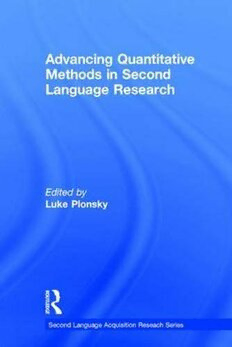Table Of ContentADVANCING QUANTITATIVE
METHODS IN SECOND
LANGUAGE RESEARCH
By picking up where introductory texts have left off, Advancing Quantitative
Methods in Second Language Research provides a “second course” on quantitative
methods and enables second language researchers to both address questions cur-
rently posed in the field in new and dynamic ways and to address novel or more
complex questions as well. In line with the practical focus of the book, each
chapter provides the conceptual motivation for and step-by-step guidance needed
to carry out a relatively advanced, novel, and/or underused statistical technique.
Using readily available statistical software packages such as SPSS, the chapters walk
the reader from conceptualization through to output and interpretation of a range
of advanced statistical procedures such as bootstrapping, mixed effects modeling,
cluster analysis, discriminant function analysis, and meta-analysis. This practical
hands-on volume equips researchers in applied linguistics and second language
acquisition (SLA) with the necessary tools and knowledge to engage more fully
with key issues and problems in SLA and to work toward expanding the statistical
repertoire of the field.
Luke Plonsky (PhD, Michigan State University) is a faculty member in the
Applied Linguistics program at Northern Arizona University. His interests include
SLA and research methods, and his publications in these and other areas have
appeared in Annual Review of Applied Linguistics, Applied Linguistics, Language Learn-
ing, Modern Language Journal, and Studies in Second Language Acquisition, among
other major journals and outlets. He is also Associated Editor of Studies in Second
Language Acquisition and Managing Editor of Foreign Language Annals.
SECOND LANGUAGE ACQUISITION RESEARCH SERIES
Susan M. Gass and Alison Mackey, Series Editors
Monographs on Theoretical Issues:
Schachter/Gass
Second Language Classroom Research: Issues and Opportunities (1996)
Birdsong
Second Language Acquisition and the Critical Period Hypotheses (1999)
Ohta
Second Language Acquisition Processes in the Classroom: Learning Japanese (2001)
Major
Foreign Accent: Ontogeny and Phylogeny of Second Language Phonology (2001)
VanPatten
Processing Instruction: Theory, Research, and Commentary (2003)
VanPatten/Williams/Rott/Overstreet
Form-Meaning Connections in Second Language Acquisition (2004)
Bardovi-Harlig/Hartford
Interlanguage Pragmatics: Exploring Institutional Talk (2005)
Dörnyei
The Psychology of the Language Learner: Individual Differences in Second
Language Acquisition (2005)
Long
Problems in SLA (2007)
VanPatten/Williams
Theories in Second Language Acquisition (2007)
Ortega/Byrnes
The Longitudinal Study of Advanced L2 Capacities (2008)
Liceras/Zobl/Goodluck
The Role of Formal Features in Second Language Acquisition (2008)
Philp/Adams/Iwashita
Peer Interaction and Second Language Learning (2013)
VanPatten/Williams
Theories in Second Language Acquisition, Second Edition (2014)
Leow
Explicit Learning in the L2 Classroom (2015)
Dörnyei/Ryan
The Psychology of the Language Learner—Revisited (2015)
Monographs on Research Methodology:
Tarone/Gass/Cohen
Research Methodology in Second Language Acquisition (1994)
Yule
Referential Communication Tasks (1997)
Gass/Mackey
Stimulated Recall Methodology in Second Language Research (2000)
Markee
Conversation Analysis (2000)
Gass/Mackey
Data Elicitation for Second and Foreign Language Research (2007)
Duff
Case Study Research in Applied Linguistics (2007)
McDonough/Trofimovich
Using Priming Methods in Second Language Research (2008)
Dörnyei/Taguchi
Questionnaires in Second Language Research: Construction, Administration, and
Processing, Second Edition (2009)
Bowles
The Think-Aloud Controversy in Second Language Research (2010)
Jiang
Conducting Reaction Time Research for Second Language Studies (2011)
Barkhuizen/Benson/Chik
Narrative Inquiry in Language Teaching and Learning Research (2013)
Jegerski/VanPatten
Research Methods in Second Language Psycholinguistics (2013)
Larson-Hall
A Guide to Doing Statistics in Second Language Research Using SPSS and R,
Second Edition (2015)
Plonsky
Advancing Quantitative Methods in Second Language Research (2015)
Of Related Interest:
Gass
Input, Interaction, and the Second Language Learner (1997)
Gass/Sorace/Selinker
Second Language Learning Data Analysis, Second Edition (1998)
Mackey/Gass
Second Language Research: Methodology and Design (2005)
Gass with Behney & Plonsky
Second Language Acquisition: An Introductory Course, Fourth Edition (2013)
ADVANCING
QUANTITATIVE
METHODS IN SECOND
LANGUAGE RESEARCH
Edited by
Luke Plonsky
NORTHERN ARIZONA UNIVERSITY
First published 2015
by Routledge
711 Third Avenue, New York, NY 10017
and by Routledge
2 Park Square, Milton Park, Abingdon, Oxon, OX14 4RN
Routledge is an imprint of the Taylor & Francis Group, an informa business
© 2015 Taylor & Francis
The right of Luke Plonsky to be identified as the author of the editorial
material, and of the authors for their individual chapters, has been asserted in
accordance with sections 77 and 78 of the Copyright, Designs and Patents
Act 1988.
All rights reserved. No part of this book may be reprinted or reproduced or
utilised in any form or by any electronic, mechanical, or other means, now
known or hereafter invented, including photocopying and recording, or in
any information storage or retrieval system, without permission in writing
from the publishers.
Trademark notice: Product or corporate names may be trademarks or registered
trademarks, and are used only for identification and explanation without
intent to infringe.
Library of Congress Cataloging-in-Publication Data
Plonsky, Luke.
Advancing quantitative methods in second language research / Luke
Plonsky, Northern Arizona University.
pages cm. — (Second Language Acquisition Research Series)
Includes bibliographical references and index.
1. Second language acquisition—Resesarch. 2. Second language
acquisition—Data processing. 3. Language and languages—Study and
teaching—Research. 4. Language acquisition—Research. 5. Language
acquisition—Data processing. 6. Quantitative research. 7. Multilingual
computing. 8. Computational linguistics. I. Title.
P118.2.P65 2015
401'.93—dc23
2014048744
ISBN: 978-0-415-71833-2 (hbk)
ISBN: 978-0-415-71834-9 (pbk)
ISBN: 978-1-315-87090-8 (ebk)
Typeset in Bembo
by Apex CoVantage, LLC
For Pamela
This page intentionally left blank
CONTENTS
List of Illustrations xi
Acknowledgments xvii
List of Contributors xix
PART I
Introduction 1
1 Introduction 3
Luke Plonsky
2 Why Bother Learning Advanced Quantitative Methods in L2
Research? 9
James Dean Brown
PART II
Enhancing Existing Quantitative Methods 21
3 Statistical Power, p Values, Descriptive Statistics, and Effect
Sizes: A “Back-to-Basics” Approach to Advancing Quantitative
Methods in L2 Research 23
Luke Plonsky
4 A Practical Guide to Bootstrapping Descriptive Statistics,
Correlations, t Tests, and ANOVAs 46
Geoffrey T. LaFlair, Jesse Egbert, and Luke Plonsky

